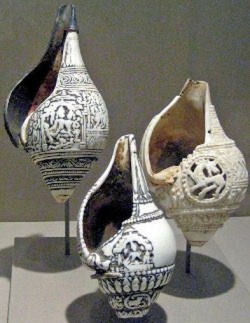Conch
Saṅkha is the marine mollusk Turbinella pyrum which is found in the waters of southern and western India.
A hole was sometimes made in the end of the shell of this creature so that it could be blown as a kind of trumpet.
The Jātaka says that the conch was sometimes blown to the accompaniment of a drum (Ja.IV,21).
The Buddha mentioned that the deep resonant sound of the conch could be heard over a long distance (D.I,251).
But it was something else about the conch which made it so special to the ancient Indians.
The conch shell is said to represent Buddha's beautiful and resonant voice, through which he introduced his followers to dharma.
In Tibetan Buddhism, the conch shell is blown from the rooftops of monasteries to gather monks together and announce religious assemblies. During the exercise of rituals, it is used as a musical instrument and as a means to contain holy water. In addition, conch shell horns are blown as a sound offering to the universe. When the conch shell is placed on top of an altar it functions as a symbolic reminder of the great Buddha and his teachings.
Shells that spiral to the right in a clockwise manner are rare and considered to be especially sacred. The right-spiraling conch is believed to symbolize the motion of the sun, moon, planets and stars. The hair on Buddha's head and body was said to have spiraled to the right. This was seen as one of the many manifestations of Buddhas deep connection to the universe.
The thick, dense shell can be polished to an unusually pure, shiny white. This made it a symbol of purity, goodness and perfection The Buddha described the life of the virtuous, disciplined monk a being `perfectly clean, perfectly pure and polished like a conch shell.' (A.V,204; D.I,63).
Conch shells were considered one of the ten precious things found in the ocean along with pearl crystal beryl quartz red coral silver gold, ruby and emerald (Ud.54).
To have three wrinkles on the neck like the lines of the spiral on a conch was considered a sign of beauty (Ja.V,155; IV,130) and shells spiraling to the right, which are extremely rare, were considered particularly auspicious (Ja.IV,350).
In time, the conch came to be considered, not just beautiful, but also sacred. During coronation ceremonies water from three conch shells was sprinkled on the monarch's head (Ja.II,409; IV,493) and they were and still are widely used in Hindu,
Buddhist, Hindu and Sikh religious ceremonies. A conch is often blown to mark the commencement important events.
